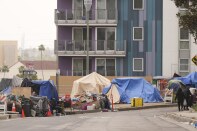Truth matters. Community matters. Your support makes both possible. LAist is one of the few places where news remains independent and free from political and corporate influence. Stand up for truth and for LAist. Make your year-end tax-deductible gift now.
LA's official homeless tally increasingly undercounts people on the streets, RAND study finds

An official homeless count captured just 68% of the unsheltered population in three key city of L.A. neighborhoods this year, according to a RAND Corporation report released today.
RAND researchers also found the Los Angeles Homeless Services Authority's annual count decreased in accuracy over the past two years.
The Santa Monica-based think tank conducts its own professional count in Skid Row, Venice and Hollywood. Despite its assertion of a LAHSA undercount, the RAND report shows homelessness declining in the areas it surveys in recent years — a trend LAHSA has reported across the region.
LAHSA’s official count in those Los Angeles neighborhoods previously had aligned with RAND’s own estimates, but a 26% undercount emerged in 2024 and widened to 32% this year, RAND found.
"In 2022 and 2023, at least in the areas where we count, the [Point-in-Time count] was, as far as I can tell, excellent,” said Louis Abramson, lead author of the RAND report. “I don't know what has happened afterwards."
LAHSA's potential undercounts coincide with a rise in “rough sleepers,” who live outside without the protection of a vehicle, tent or makeshift dwelling.
L.A. increasingly has removed tent encampments through programs such as Inside Safe. That has meant rough sleepers and vehicle dwellers — both harder to count accurately — have become a larger share of the homeless population.
“It used to be that the easiest-to-count population was also the dominant population,” Abramson said. “So if you were getting the tent dwellers right, you were probably getting the needs right. But if more of your population is rough sleeping, this is going to be a problem.”
The official undercount varied significantly by neighborhood, RAND found. Hollywood's official tally captured 81% of what RAND found. Skid Row's was just 61% accurate. Venice fell in between — at 76%.
“The places with the highest needs are becoming the very places where the county's official count is most underestimated,” the report states.
LAHSA Chief Executive Gita O’Neill said she hadn’t seen RAND’s report yet but hopes to compare notes. O’Neill said she welcomes more counts by researchers, school districts or neighborhoods — and called the annual count vital but “not the last word on understanding homelessness in our region.”
She added that RAND could get more involved.
“We would also encourage volunteering by expert RAND team members to assist with future counts in the neighborhoods they’ve studied,” O’Neill said. “Other areas, like Beverly Hills, that conduct their own monthly counts volunteer each year.”

Why it matters
If a fix isn’t made, the RAND report warns, LAHSA’s flawed counts threaten to misdirect hundreds of millions in funding.
The official count’s results determine how more than $300 million in federal and local dollars flow across L.A. County each year.
That includes $220 million from the U.S. Department of Housing and Urban Development and about $96 million allocated to cities under L.A. County’s Measure A sales tax to fund homeless services.
If count accuracy varies dramatically by neighborhood, some cities could receive 30% more funding per unsheltered person than others, according to the report.
The 2024 and 2025 discrepancies in RAND’s report also raise questions about reported declines in homelessness.
City officials have celebrated two consecutive years of declining homelessness, reporting a drop of approximately 2,300 unsheltered people this year.
If the pattern RAND researchers observed holds across Los Angeles, up to 7,900 people and dwellings may be missing from the city's most recent count, according to the report.
The RAND data covers about 10% of the city of L.A.’s unsheltered population in three neighborhoods. LAHSA's Point-in-Time count is countywide and mandated by the U.S. Department of Housing and Urban Development. It relies on thousands of local volunteers.
Since 2022, L.A.'s lead homelessness agency has used a mobile app plagued by repeated technical issues. After last year’s count, LAHSA officials said issues with the app “increased doubts and concerns about the technology and reliability of the data.”
A straightforward fix?
This isn’t the first time the accuracy of L.A.’s official homeless count has come into question.
A 2017 Economic Roundtable report found L.A.’s homeless count lacked reliable year-to-year comparability because of inconsistent methods and data collection across different counts.
LAist reported in June that LAHSA’s inconsistent data processing policies during 2024’s count led to more volunteer observations being discarded within the city of L.A. than the previous year.
RAND’s report adds new concerns, but the think tank also offers a solution. It says LAHSA should deploy professional field teams to independently cross-check volunteer counts during the annual tally.
These teams would survey selected census tracts on the same night as volunteers, and those professional results could then be used to adjust the volunteer counts across the city.
If they found, say, 20% more people than volunteers did in a representative sample of neighborhoods, LAHSA could make statistical corrections citywide. The professionals wouldn't need to cover all 2,800-plus census tracts that volunteers survey.
"You don't need a huge number of these teams," Abramson said. "It's not that expensive in general."
These teams may be fundable through L.A. County’s Measure A, the RAND report points out.
The RAND report calls the fix "one of the easy wins" in homelessness policy.














